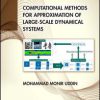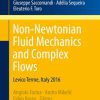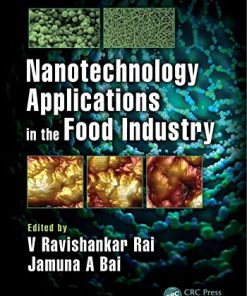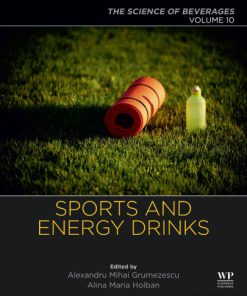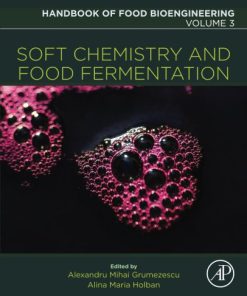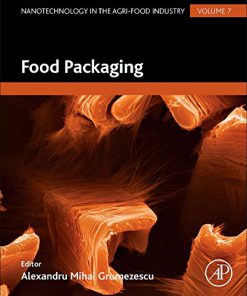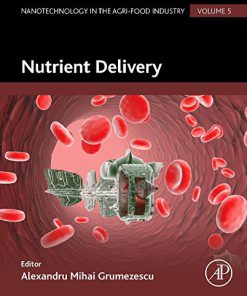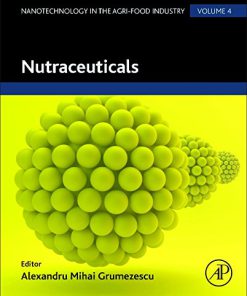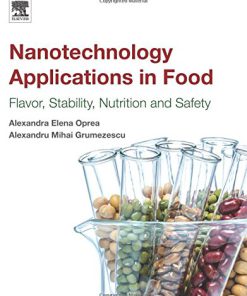Encapsulations Nanotechnology in the Agri Food Industry Volume 2 1st Edition by Alexandru Grumezescu 9780128043073 0128043075
$50.00 Original price was: $50.00.$25.00Current price is: $25.00.
Encapsulations Nanotechnology in the Agri Food Industry Volume 2 1st Edition by Alexandru Grumezescu – Ebook PDF Instant Download/Delivery:9780128043073,0128043075
Full download Encapsulations Nanotechnology in the Agri Food Industry Volume 2 1st Edition after payment

Product details:
ISBN 10:0128043075
ISBN 13:9780128043073
Author:Alexandru Grumezescu
Encapsulations, a volume in the Nanotechnology in the Agri-Food Industry series,presents key elements in establishing food quality through the improvement of food flavor and aroma. The major benefits of nanoencapsulation for food ingredients include improvement in bioavailability of flavor and aroma ingredients, improvement in solubility of poor water-soluble ingredients, higher ingredient retention during production process, higher activity levels of encapsulated ingredients, improved shelf life, and controlled release of flavor and aroma. This volume discusses main nanoencapsulation processes such as spray drying, melt injection, extrusion, coacervation, and emulsification. The materials used in nanoencapsulation include lipids, proteins, carbohydrates, cellulose, gums, and food grade polymers. Applications and benefits of nanoencapsulation such as controlled release, protections, and taste masking will be explained in detail.
- Includes the most up-to-date information on nanoencapsulation and nanocontainer-based delivery of antimicrobials
- Presents nanomaterials for innovation based on scientific advancements in the field
- Provides control release strategies to enhance bioactivity, including methods and techniques for research and innovation
- Provides useful tools to improve the delivery of bioactive molecules and living cells into foods
Encapsulations Nanotechnology in the Agri Food Industry Volume 2 1st Table of contents:
1: Electrohydrodynamic microencapsulation technology
Abstract
1. Introduction
2. Electrohydrodynamic Atomization
3. Micro- and Nanoencapsulation Techniques
4. Electrohydrodynamic Micro- and Nanoencapsulation
5. Electrohydrodynamic Microencapsulation for Food Processing
6. Conclusions
2: Exploring nanoencapsulation of aroma and flavors as new frontier in food technology
Abstract
1. Introduction
2. Nanoencapsulation of Aroma and Flavors
3. Advantages of Nanoencapsulation of Flavor and Aroma Compounds
4. Quality Assessment by Instrumental Methods to Predict Flavor and Aroma in Food Products
5. Safety and Risk Assessment of Nanotechnology and Nanofoods
6. Conclusions
3: Nanoencapsulation of flavors and aromas by emerging technologies
Abstract
1. Introduction
2. Issues Relating to Addition of Flavors and Aromas in Foods
3. Nanoencapsulation of EOs
4. Emerging Technologies
5. Conclusions and Future Perspectives
Acknowledgments
4: Cyclodextrins as encapsulation material for flavors and aroma
Abstract
1. Introduction
2. Aroma and Flavors
3. Cyclodextrins
4. Cyclodextrins/Aroma Inclusion Complexes
5. Effects of Encapsulation
6. Conclusions
5: Structural and thermodynamic insight into the potentiality of food biopolymers to behave as smart nanovehicles for essential polyunsaturated lipids
Abstract
1. Introduction
2. Intermolecular Forces Underlying the Encapsulation of the Polyunsaturated Lipids by the Biopolymers
3. Protection Ability of the (Biopolymer + Lipids) Complexes Against Oxidation of the Encapsulated Lipids
4. Structural and Thermodynamic Parameters of the (Biopolymer + Lipids) Complex Particles Underlying Their Protective Abilities Against Oxidation of the Encapsulated Lipids
5. Thermodynamic Parameters Controlling Solubility of the (Biopolymer + Lipids) Complex Particles in an Aqueous Medium
6. Structural Parameters of the Biopolymer Nanovehicles Controlling Release of the Polyunsaturated Lipids in Vitro
7. Conclusions
Acknowledgments
6: Encapsulation: entrapping essential oil/flavors/aromas in food
Abstract
1. Introduction
2. New Technologies: Future Course
3. Nanotechnology
4. Matrix or Coating Materials
5. Encapsulation Processes
6. Edible Films Formed in Encapsulation
7. Retention of Volatiles
8. Storage Stability
9. Conclusions
7: Antimicrobials from herbs, spices, and plants
Abstract
1. Nanoencapsulation of Natural Antimicrobial Products
2. Encapsulation Process
3. Encapsulation Techniques
4. Encapsulation of Lipophilic Antimicrobials
5. Nano- Versus Microencapsulation
6. Conclusions
8: Supramolecular strategy of the encapsulation of low-molecular-weight food ingredients
Abstract
1. Introduction
2. Self-Assembled Delivery Systems Based on Amphiphilic Compounds
3. Polymer-Based Formulations as Delivery Systems
4. Molecular Complexes Based on the Guest–Host Interactions
5. Conclusions
Acknowledgment
9: Novel approaches in nanoencapsulation of aromas and flavors
Abstract
1. Introduction
2. Flavor Nanoencapsulation by Spray Drying
3. Flavors Encapsulated in Nanoemulsions
4. Encapsulation of Flavors in Lipid-Based Nanoparticles
5. Flavors Encapsulated in Liposomes
6. Flavors Encapsulated in Cyclodextrins
7. Flavors Encapsulated in Complex Coacervates
8. Conclusions
Acknowledgment
10: Nanocomposite for food encapsulation packaging
Abstract
1. Introduction
2. Nanocomposite for Food Encapsulation Packaging
3. Preparation Methods
4. Surface Adhesion
5. New Concepts in Food Encapsulation
6. Industry, Enterprise, and Market
7. Limitations and Shortcomings
8. Conclusions
11: Microencapsulated bioactive components as a source of health
Abstract
1. Introduction
2. Microencapsulation
3. Antioxidant Properties of Phenolic Compounds
4. Microencapsulation via Emulsion of Chilean Blackberry
5. Conclusions
12: Biocompatible microemulsions for the nanoencapsulation of essential oils and nutraceuticals
Abstract
1. Introduction
2. Examples of Components and Characterization Procedures
3. Discussions
4. Conclusions and Outlook
Acknowledgments
13: Nanoencapsulation strategies applied to maximize target delivery of intact polyphenols
Abstract
1. Introduction
2. Encapsulation Technologies
3. Controlled Release of Polyphenols in the Gut
4. Conclusions
14: Nanoencapsulation technology to control release and enhance bioactivity of essential oils
Abstract
1. Introduction
2. Chemical Composition of EOs
3. Limits and Challenges for the Use of Essential Oils for Their Biological Activities
4. Nanoencapsulation Technology
5. Nanoencapsulated Delivery of EOs
6. Polymer-Based Nanoparticles
7. Lipid-Based Nanoencapsulation
8. Molecular Complexes
9. Conclusions
15: Nanoencapsulation of essential oils for sustained release: application as therapeutics and antimicrobials
Abstract
1. Introduction
2. Chemical Composition of Essential Oils
3. Nanoencapsulation Strategies of Essential Oils for Various Biological Activities
4. Inclusion Complexes
5. Future Prospects
16: Nanoencapsulation and nanocontainer based delivery systems for drugs, flavors, and aromas
Abstract
1. Introduction
2. Nanocontainers for Delivery System
3. Mechanism of Response
4. Active Molecules to be Delivered
5. Stimuli for Controlled Release
6. Case Study
7. Future Prospects
8. Conclusions
17: Cyclodextrins-based nanocomplexes for encapsulation of bioactive compounds in food, cosmetics, and pharmaceutical products: principles of supramolecular complexes formation, their influence on the antioxidative properties of target chemicals, and recent advances in selected industrial applications
Abstract
1. Introduction
2. Cyclodextrins and Their Complexes
3. General Information about Free Radicals
4. Antioxidants
5. Analysis of Antioxidants
6. Encapsulation of Selected Antioxidants by Cyclodextrins
7. Recent Advances of Cyclodextrins Application in Pharmaceutics, Food, and Cosmetics Products
8. Conclusions
18: Nanoencapsulation of flavors and aromas by cyclodextrins
Abstract
1. Introduction
2. History of Flavor Encapsulation by Cyclodextrins
3. Approval Status of Cyclodextrins
4. Formulation of Flavors with Cyclodextrins: Methods of Preparation, and Analysis
5. Flavor Complexes in Food Processing
6. Cyclodextrins in Aroma Preserving and Antibiotic Active Food Packaging
7. Conclusions
19: Natural biopolymers as nanocarriers for bioactive ingredients used in food industries
Abstract
1. Introduction
2. Natural Biopolymers Used in Nanoencapsulation
3. Methods of Fabrication of Nanoparticles from Natural Polymers
4. Nanoencapsulation of Bioactive Food Ingredients
5. Bioavailability and Toxicity
6. Conclusions and Future Trends
Abbreviations
20: Process technology of nanoemulsions in food processing
Abstract
1. Introduction
2. Thermodynamics of Nanosized and Nanoemulsion Production Technologies
3. High-Energy Production Technologies of Nanoemulsions
4. Low-Energy Production Technologies of Nanosized Emulsifiation
5. Functional Characterization Processes of Nanoemulsions
6. Application of Nanoemulsion Science in Food Processing
7. Conclusions
People also search for Encapsulations Nanotechnology in the Agri Food Industry Volume 2 1st:
what is nanotechnology in cosmetics
hydrogel encapsulation
what is nanotechnology and application of nanotechnology
encapsulation in nanotechnology
disadvantages of nanotechnology in medicine
Tags:
Alexandru Grumezescu,Food,Encapsulations,Nanotechnology
You may also like…
Science (General)
Science (General)
Technique - Food Manufacturing
Technique - Food Manufacturing
The Science of Beverages Volume 10 Sports and Energy Drinks 1st Edition Alexandru Grumezescu
Technique - Food Manufacturing
Biology and other natural sciences - Plants: Agriculture and Forestry
Science (General)


